Whale Art
Constance Sartor putting finishing touches on her Cuvier’s beaked whale (Ziphius caviroristris) mom and calf mural in the Bonehenge Whale Center, Beaufort, NC. (January 2020)
Both art and science exemplify observation and interpretation. There is a confluence of art and science developing in the Bonehenge Whale Center. Many artistic contributions, often based on actual whales we have encountered, inform and inspire us, relax us, make us smile, and motivate us to ask and answer questions. They teach about whale biology and behavior, human culture, and how we can learn about whales. They offer images of animals that we generally only get partial glimpses of in the wild. We hope some of the art may inspire conservation as well.

Constance Sartor is a marine biologist and artist who uses her scientific eye to communicate and inform us of awe inspiring and beautiful aspects of nature through visual art. (Read more...)
Her mural in the Bonehenge Whale Center commemorates the adult female Cuvier’s beaked whale that stranded dead on the ocean beach of Fort Macon State Park, North Carolina, in June 2017. It is rare for a human to get a good look at Cuvier’s beaked whales as they spend much of their time in deep dives. Viewing the mural gives us an idea what the live whale and her calf would look like in their natural environment. The squid in the painting depict what Cuvier’s beaked whales suck up and eat. The mural also features glow-in-the-dark components that are only viewable after dark (see below).
For our Bonehenge building where we re-articulated the sperm whale skeleton, Karen Hattman designed and painted a unique and beautiful painting for the outside of the building. Click here to see more.
Dolphins use sound waves, echolocation, to “see” with sound. Like the objects in a dolphin’s environment, sometimes art can emit a visual “sound” to another person which informs or inspires them. Karen Hattman’s work “Sperm Whale Spirit”, is an example of an “echo” that inspired this mosaic by LaNelle Davis and Nan Bowles made with paint, adhesives, and pieces of glass, ceramic and porcelain.

Nan Bowles created a floor mural featuring four of our local bottlenose dolphins and more. (Click here to read more from the artist.)
Seeing the Cuvier’s Beaked whale mural in Bonehenge helps me to imagine what life might be like as a whale or what it might be like to be in the presence of a mighty whale. The images of dolphins that I paint reflect the feeling of being present with dolphins. If we humans can feel connected to the image of a whale or dolphin, the lives of these marine mammals are more easily assimilated into our image of community. As humans we are more likely to not just know marine mammals are out there swimming around, but they are right here in this painting present with us! Real members of our community. I can weave education into the artwork by showing the bones inside the flipper of a dolphin in a painting. I can do my best to create a beautiful image that draws the viewer and the dolphin into close proximity of each other. Hopefully inspiring us all to conserve and connect to the wider ocean habitats these amazing community members live in.

Notice the striking asymmetry in the skull, a feature that is predictable and consistent in deep-diving toothed whale species.

Talented and creative local crafter Dennis Neill of Wisdom Woodworks generously contributed many whale-themed items displayed in the Bonehenge Whale Center.




